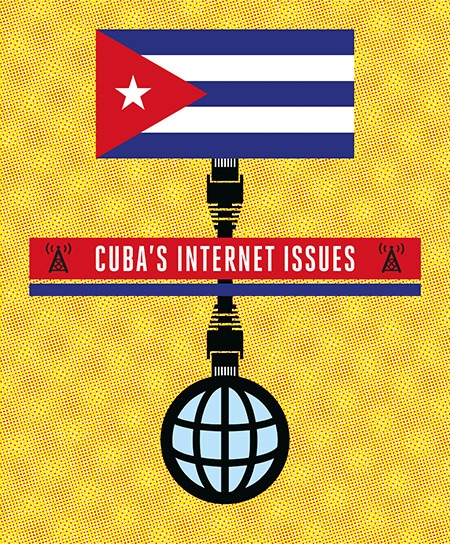Cuba's Internet Issues
Research shows that misconfigurations slow internet traffic traveling to the island
In December 2014, President Barack Obama made history by announcing plans to reestablish diplomatic relations with Cuba, including loosening economic restrictions. Two months later, American companies like Netflix and Airbnb announced plans to expand into the once-embargoed island.
 "Our first reaction was: 'Really?'" says Northwestern Engineering’s Fabián E. Bustamante. “As a business model, Netflix and Airbnb rely on most people having Internet access. That’s not quite the case in Cuba, so it really didn’t seem to make much sense.”
"Our first reaction was: 'Really?'" says Northwestern Engineering’s Fabián E. Bustamante. “As a business model, Netflix and Airbnb rely on most people having Internet access. That’s not quite the case in Cuba, so it really didn’t seem to make much sense.”
“If you’re trying to connect anywhere, you either have to connect through these marine cables or up to the satellite,” Bustamante says. “If you go up to the satellite, it takes significantly longer.”
To see if these Internet-centric business ideas were feasible, Bustamante, professor of computer science, and his graduate student Zachary Bischof decided to measure Cuba’s Internet performance. Not too surprising, they found that Cuba’s Internet connection to the rest of the world was poor, perhaps even worse than expected.
Cuba’s history with computing and the Internet is a complicated one. Cuban citizens were not even allowed to own a personal computer until 2008. Network availability has been problematic for such a long time that several makeshift “offline Internets” have appeared, with individuals distributing content through USB flash drives or CDs (a popular service known as “el paquete”).
But things have been changing, if slowly. In February 2011, Cuba completed its first undersea fiber-optic cable with a landing in Venezuela, but it didn’t activate it until two years later. Today, only one in four Cubans can get online, and a mere five percent of the population has Internet access at home.
“If you’re trying to connect anywhere, you either have to connect through these marine cables or up to the satellite,” Bustamante says. “If you go up to the satellite, it takes significantly longer.”
If you’re trying to connect anywhere, you either have to connect through these marine cables or up to the satellite. If you go up to the satellite, it takes significantly longer.
—Fabian E. Bustamante, Professor of Computer Science
“For one, it’s much farther to travel,” Bischof adds. “And the trip is on a very interference-rich environment, which includes cosmic rays.”
Since March 2015, Bustamante and Bischof have conducted measurements to and from Havana to observe Internet traffic going in and out of Cuba. They are trying to characterize overall network performance (such as the time it takes for information to travel in either direction) and the paths the data travels.
Some of the early results showed that information returning to Cuba took a much longer route than the request took on its way out of the island. When a person in Havana searches for a topic on Google, for example, the request travels through the marine cable to Venezuela, then through another marine cable to the United States, and finally lands at a Google server in Dallas. When the search result travels back, it goes to Miami, up to the satellite, and then back to Cuba. While the request for information out of Cuba takes 60 to 70 milliseconds, it takes a whopping 270 milliseconds for the response to make its way back. For websites like CNN.com, this translates into a web page taking nearly a minute to load.
“It takes so long that it’s almost useless,” Bustamante says, noting that many people will abandon their search before getting a response and the whole exploratory aspect of web research is virtually gone.
Bustamante and Bischof say this could result from a configuration problem or routing policy and are exploring this further. For now, they can only say—with certainty—that Cuba’s Internet performance appears to be among the poorest in the Americas, and its infrastructure would struggle to support web services hosted off the island, particularly network-intensive applications like Netflix. As always, understanding problems and diagnosing their causes is a first step toward a solution.
“Beyond access to Internet services like Netflix, continued societal progress in Cuba depends on better connectivity,” Bustamante says. “To better understand how to enhance it, we first have to better understand what is available now and what are the main hindrances.”
